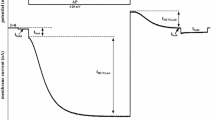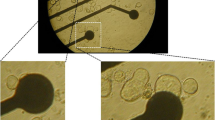Summary
In order to study the relationship between the inward Ca current activated by hyperpolarization and the frequency increase in ciliary beating, Paramecium cells were voltage clamped under conditions where K current was suppressed by use of CsCl electrodes and by extracellular tetraethyl ammonium. A 2-s pulse of hyperpolarization from the resting potential activated an inward current consisting of two components, an initial transient current peaking at 0.1–0.2 s (which had been identified as a Ca current) and a subsequent sustained current. The initial component was not associated with the frequency increase because the frequency increase was normally induced even when the peak current was almost completely inhibited by external addition of Ba2+. The second sustained current was closely correlated with the frequency increase. The frequency rose steeply with the sustained current and saturated at −0.6 nA. External addition of La3+ or replacement of Ca2+ by Mg2+ suppressed this current, and at the same time the frequency increase was inhibited. As the amplitude of the sustained current was not changed by deciliation, this current must pass through the somatic membrane. These results suggest that the frequency increase upon hyperpolarization is triggered by the voltage-activated inward current passing through the somatic membrane of the interciliary compartment.
Similar content being viewed by others
Abbreviations
- cAMP:
-
cyclic adenosine monophosphate
- HEPES:
-
hydroxyethylpiperazine ethanesulfonate
- TEA+ :
-
tetraethyl ammonium
References
Bonini NM, Gustin MC, Nelson DL (1986) Regulation of ciliary motility by membrane potential in Paramecium: a role for cyclic AMP. Cell Motil Cytoskeleton 6:256–272
Brehm P, Eckert R (1978) An electrophysiological study of the regulation of ciliary beating frequency in Paramecium. J Physiol (Lond) 283:557–568
Deitmer JW, Machemer H (1982) Osmotic tolerance of Ca-dependent excitability in the marine ciliate Paramecium calkinsi. J Exp Biol 97:311–324
Eckert R (1972) Bioelectric control of ciliary activity. Science 176:473–481
Friedman K, Eckert R (1973) Ionic and pharmacological modification of input resistance and excitability in Paramecium. Comp Biochem Physiol 45A: 101–114
Hennessey TM (1987) A novel calcium current is activated by hyperpolarization of Paramecium tetraurelia. Soc Neurosci Abstr 13:108
Hennessey TM, Machemer H, Nelson DL (1985) Injected cyclic AMP increases ciliary beat frequency in conjunction with membrane hyperpolarization. Eur J Cell Biol 36:153–156
Hinrichsen RD, Saimi Y (1984) A mutation that alters properties of the calcium channel in Paramecium tetraurelia. J Physiol (Lond) 351:397–410
Machemer H (1974) Frequency and directional responses of cilia to membrane potential changes in Paramecium. J Comp Physiol 92:293–316
Machemer H (1976) Interactions of membrane potential and cations in regulation of ciliary activity in Paramecium. J Exp Biol 65:427–448
Machemer H, Eckert R (1973) Electrophysiological control of reversed ciliary beating in Paramecium. J Gen Physiol 61:572–587
Machemer H, Eckert R (1975) Ciliary frequency and orientational responses to clamped voltage steps in Paramecium. J Comp Physiol 104:247–260
Machemer H, Ogura A (1979) Ionic conductances of membranes in ciliated and deciliated Paramecium. J Physiol (Lond) 296:49–60
Mogami Y, Machemer H (1991) In vivo activation of cirral movement in Stylonychia by calcium. J Comp Physiol A 168:687–695
Naitoh Y, Eckert R (1974) The control of ciliary activity in Protozoa. In: Sleigh MA (ed) Cilia and flagella. Academic, London, pp 305–352
Nakaoka Y, Machemer H (1990) Effects of cyclic nucleotides and intracellular Ca on voltage-activated ciliary beating in Paramecium. J Comp Physiol A 166:401–406
Nakaoka Y, Ooi H (1985) Regulation of ciliary reversal in triton-extracted Paramecium by calcium and cyclic adenosine monophosphate. J Cell Sci 77:185–195
Nakaoka Y, Tanaka H, Oosawa F (1984) Ca2+-dependent regulation of beat frequency of cilia in Paramecium. J Cell Sci 65: 223–231
Oka T, Nakaoka Y (1989) Inactivation and activation of inward current during adaptation to potassium ions in Paramecium caudatum. Cell Struct Function 14:209–216
Oka T, Nakaoka Y, Oosawa F (1986) Changes in membrane potential during adaptation to external potassium ions in Paramecium caudatum. J Exp Biol 126:111–117
Pape HC, Machemer H (1986) Electrical properties and membrane currents in the ciliate Didinium. J Comp Physiol A 158:111–124
Preston RR, Saimi Y (1990a) A hyperpolarization-activated calcium current that is inhibited by barium in Paramecium tetraurelia. Biophys J 57:519a
Preston RR, Saimi Y (1990b) Calcium ions and the regulation of motility in Paramecium. In: Bloodgood RA (ed) Ciliary and flagellar membranes. Plenum, New York pp 173–199
Saimi Y (1986) Calcium-dependent sodium currents in Paramecium: mutational manipulations and effects of hyper- and depolarization. J Membr Biol 92:227–236
Saimi Y, Kung C (1987) Behavioral genetics of Paramecium. Annu Rev Genet 21:47–65
Satir P (1985) Switching mechanisms in the control of ciliary motility. In: Satir BH (ed) Modern cell biology, vol 4. Liss, New York, pp 1–46
Schultz JE, Grünemund R, Hirschhansen R, Schönefeld U (1984) Ionic regulation of cyclic AMP levels in Paramecium tetraurelia in vivo. FEBS Lett 167:113–116
Author information
Authors and Affiliations
Rights and permissions
About this article
Cite this article
Nakaoka, Y., Iwatsuki, K. Hyperpolarization-activated inward current associated with the frequency increase in ciliary beating of Paramecium . J Comp Physiol A 170, 723–727 (1992). https://doi.org/10.1007/BF00198983
Accepted:
Issue Date:
DOI: https://doi.org/10.1007/BF00198983




